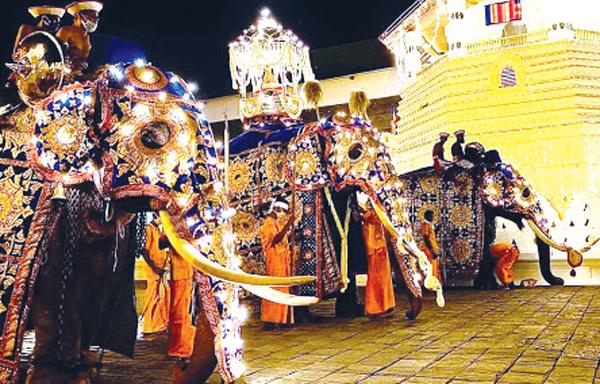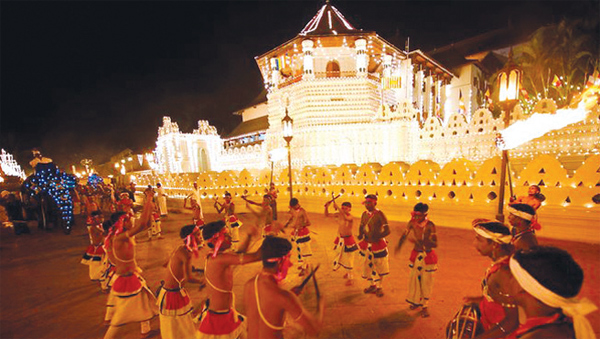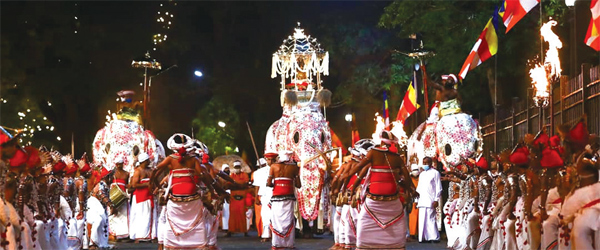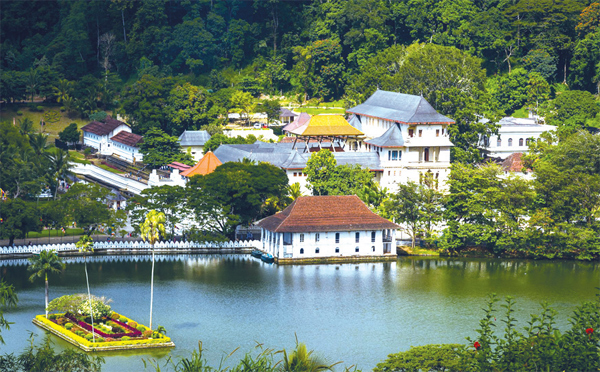
The month of Esala is here and with it comes the historic Esala Perahera of the Sri Dalada Maligawa. In this article Seth Ranwala tells us all about this timeless pageant.
History
The heat was unbearable, there were no signs of rain, the country folk had lost hope about the harvest and the English rulers found it even harder to handle the situation. People tried to reason with the rulers who had usurped the beloved country that the ancient ritual of invoking the blessings of the Sacred Tooth Relic must be followed, but the rulers kept ignoring them. The country needed rain, fast. Farms had gone to nothing and life stock was rotting away, and the peasants were miserable. Everyone in the country knew what should be done in a situation like this. The Sacred Tooth Relic needed to see the light of day. Some were of the opinion that the reason for this drought was the relic itself not being worshipped by devotees.
Finally, the English agreed to cooperate and listen to the people, but the stakes were high; if the festival failed to bring rain the English will certainly punish the civilians severely, but to the amazement of the rulers on the day of the festival it started raining like never before causing the families of Kandy to weep for joy.
 This miracle was the power of the Sacred Tooth Relic that the people of this country looked up to every year, month and day. To venerate the Sacred Tooth Relic, we have the annual Esala Perahera. This tradition dates back to BC302 when Prince Dantha and Princess Hemamala brought the relic to Sri Lanka during the reign of King Kithsirimevan and handed it to him for safekeeping.
This miracle was the power of the Sacred Tooth Relic that the people of this country looked up to every year, month and day. To venerate the Sacred Tooth Relic, we have the annual Esala Perahera. This tradition dates back to BC302 when Prince Dantha and Princess Hemamala brought the relic to Sri Lanka during the reign of King Kithsirimevan and handed it to him for safekeeping.
The Sacred Tooth Relic was initially kept at the Meghagiri monastery now known as Isurumuniya. Later, it was placed in the Dhamma Cakka Geha , a mansion built by King Devanampiyatissa.
King Kithsirimevan ordered a festival to be held in honour of the Sacred Tooth Relic and during the festival rains occurred so the king saw this as a way to sustain the farming industry by holding the festival annually to invoke rain. The Sacred Tooth Relic was taken in procession to the Abhayagiri Vihara annually and kept there for three months.
It is believed that this decision by King Kithsirimewan was the origin of the Esala Perahera we know today. King Wimaladharmasuriya the First had the Sacred Tooth Relic to Kandy from the Delgamuwa Vihara in the Ratnapura district where it had been hidden in a kurahan gala for safety.
The Perahera was better organised and improved by King Keerthisri Rajasinha who was guided by the Ven. Asarana Sarana Velivita Saranankara thera, during the days of the Kandyan Kingdom.
Today’s Esala Perahera
The Kap Situweema, the planting of a branch from a tree cut into four at the four Devala premises marks the start of the Perehara season.
Today, the Esala Perahera starts from the Sri Dalada Maligawa in Kandy and goes all the way around the city and back.

The Perahera goes on for 10 consecutive days and is divided into two sections as the Kumbal Perahera (the first five days) and the Randoli Perahera (the last five days). In the first five days of the Perahera also known as the Kumbal Perahera it is a tradition to dress in white, and on these days novice dancers or trainees are permitted to participate and gain experience, but in the following days only the experienced dancers are permitted to perform in the Perahera proper or the Randoli Perahera. The casket containing the Sacred Tooth Relic is carried by a majestic tusker who walks with the utmost dignity and care.

The Kandy Esala Perahera consists of five pageants, the Dalada Perahera, and the Natha, Vishnu, Kataragama and Paththini Devala Peraheras.
Several officers participate in the Perahera. The Diyawadana Nilame or the Lay Custodian of the Sacred Tooth Relic is the chief of them. The Perahara is led by the Peramune Rala or the Royal Officer of the Front who carries the Lekam Miti, an ola leaf manuscript describing the duties of various officers serving the Temple of the Sacred Tooth Relic.

Whip crackers (kasakarayas) herald the Perahera and Kandyan dancers and drummers, fire dancers, li keli dancers, kavadi dancers and many other dancers and drummers participate in this magnificent pageant.
The Diya Kapana (water cutting) ceremony takes place on the Mahaweli river at Getambe after the final Randoli Perahera.

Sources: Mahinda Kumara Dalupotha
The Festival of the Sacred Tooth: Prof. J.B. Disanayaka
The Sacred Tooth Relic and the Temple of the Tooth
The Sacred Tooth Relic is one of the four canine teeth of the Buddha recovered from his funeral pyre in Kusinagar, India. The Sacred Tooth Relic’s original home was in Dantepura, in the State of Kalinga on the Eastern coast of India.
King Gutasiva of Kalinga was a devout Buddhist and he feared that the Sacred Tooth Relic would be harmed by the Hindu Kings. He asked his daughter Princess Hemamala and her husband Prince Dantha to take the Sacred Tooth Relic to Sri Lanka for safety. The princess disguised herself as an ordinary woman and hid the sacred Tooth Relic in her hair.
Arrival of the Sacred Tooth Relic
Prince Dantha and Princess Hemamala landed at Lankapattana and walked all the way to Anuradhapura and handed the Sacred Tooth Relic to King Kirthisirimewan who received it joyfully and gave the Sacred Tooth Relic all honour. He ultimately deposited in the Dhamma Cakka Geha buit by King Devanampiyatissa during whose reign Buddhism was introduced to the island.
The Sri Dalada Maligawa
After King Kithsirimewan’s reign, the Sacred Tooth Relic went all around the country over the ages and finally came to rest in Kandy. King Vimaladharmasuriya the First (1591-1604) built a structure, a castle to contain the Sacred Tooth Relic; this castle was known as the Sri Dalada Maligawa or the Dalada Castle. But after the Portuguese attack the first Dalada Maligawa was left in ruins.
Not long after, King Rajasinha the Second (1635-1687) rebuilt it only to have it turned to ashes by the Dutch. After that King Vimaladarmasuriya the Second, finally, rebuilt the Sri Dalada Maligawa to its former glory.
After many years of improvement, Sri Vikrama Rajasinha (the last king of Sri Lanka) added some amazing and iconic features to the Sri Dalada Maligawa, such as: The cloud wall (Valakulu Bamma) and the Paththirippuwa.
After all those years of effort and planning the Sri Dalada Maligawa was conserved as a World Heritage Site in 1988. The Sacred Tooth Relic reposing within the walls of the Sri Dalada Maligawa has been blessing citizens of Sri Lanka with hope and faith along with rains for thousands of years and will do so in the years to come.

